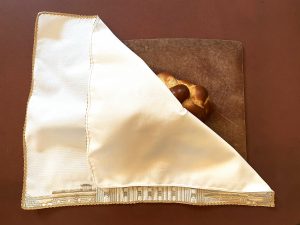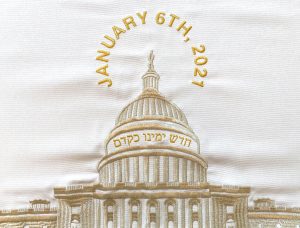

Aimee Rubensteen (AR): “Renew Our Days” references part of a phrase from אֵיכָה, Lamentations, 5:21, a book that mourns the destruction of the First Temple: הֲשִׁיבֵ֨נוּ יְהוָ֤ה ׀ אֵלֶ֙יךָ֙ ונשוב [וְֽנָשׁ֔וּבָה] חַדֵּ֥שׁ יָמֵ֖ינוּ כְּקֶֽדֶם. The translation is “Take us back, Hashem, to Yourself, And let us come back; Renew our days as of old!” Can you walk us through the Hebrew text and its interpretations? I’m also curious to learn more about your research process that led you to select this phrase, a plea of renewal. You mentioned working with a rabbi too. What was the conversation around interpretation of this phrase as it applies to the challah cover, as well as the role of interpretation of text in Jewish study?
Danielle Durchslag (DD): The robust history of Torah interpretation in Jewish life definitely informed my choices for this piece. For centuries, Jews have sat together, analyzing and debating Torah and Talmud, often gleaning entirely contradictory meanings from the same exact word or phrase. Compellingly, though, all Torah study can be viewed as a nostalgic act, as it attempts to approach and answer contemporary issues through the words of either ancient men or an ancient God — depending on your belief set around the Torah’s origins. Thus, the ritual of analyzing Torah felt like a strong reference point for “Renew Our Days,” which critiques the role of nostalgia in contemporary political discourse.
When planning this piece, I once again turned to my friend, Rabbi Matt Green, of Congregation Beth Elohim in Brooklyn, for guidance. After describing my intent to him, we naturally landed on the Book of Lamentations as the right place to search for text. It depicts the destruction of the first Temple, which felt like an appropriate analog to the events of January 6th.
We landed on this specific phrase because of its capacity for oppositional, nostalgic interpretation. If you voted for Trump, these words translate super easily to the Torah’s own version of “Make America Great Again.” If you did not vote for him, and identify as a mainstream, establishment Democrat, the same words harken back longingly to a time before Trump, before QAnon, before a reality where January 6th seemed possible.
Both readings focus nostalgically on the past as a better version of reality, but through contrasting value systems. Both idolize and oversimplify a time that came before. Neither beckons toward a changed, improved tomorrow. I needed a phrase for the challah cover that speaks to political nostalgia for both political camps, mainstream Republicans and centrist Democrats, and this one does.
AR: The use of this quote suggests an uncomfortable convergence of ideologies of renewal and return in Jewish texts and those produced by the Trump campaign and administration (e.g. ‘Make America Great Again’). How were you thinking about the uses of Jewish texts and themes in contemporary politics?
DD: Watching the co-opting of Jewish history, imagery, and, specifically, Jewish suffering, on the political far-right in recent years has been extremely upsetting. I’m responding to this question in a political context where a sitting congresswoman has publicly compared the yellow stars forced on European Jews during the Shoah to vaccine confirmation stickers. A context where only some, far from all, of her Republican colleagues have denounced her statements and seem to have no plans to censure or remove her. A context where non-Jewish, far-right protesters routinely bring and play shofars at MAGA rallies. It’s disturbing, to say the least.

AR: The US Capitol site replaces the typical iconography of the Jerusalem Temple as the challah cover’s central motif. It calls us to question: is this commemorating celebration or destruction? Good and evil are not necessarily absolutes. How does the deliberate irony in your piece work beyond simplistic ethical binaries?
DD: This object speaks to two distinct but ubiquitous aspects of Jewish cultural output. If you identify with the people who stormed the Capitol, it’s an example of celebratory objects that commemorate might, such as menorahs and dreidels, lauding Jewish military power and defiance. If you identify as a centrist Jewish Democrat, it’s an object inspired by and keeping with the mournful tradition of warning and defense (e.g. “Never Again”) wherein Jews employ posters and sculptures and art pieces to memorialize past, communal traumas.
Both aesthetic traditions, meaningfully, look backward rather than forward, focused on honoring or decrying the past rather than imagining a profoundly changed and improved future.
AR: Why a challah cover? Of all the ritual objects, why this one? Also, what drew you to this specific style of embroidery?
DD: No matter how you perceive the events of January 6th, it was, undeniably, a gathering ritual. The challah cover, for me, always serves as a physical invitation to gathering. Observant Jews of all political identities crowd around challah covers on Friday nights, in small or large groups, and follow a specific set of practices.
I also chose to create a challah cover for its aesthetic tradition. Many challah covers employ embroidery to depict architecture — often sewn portraits of buildings or synagogues in Israel. During and since January 6th, the descriptions of the Capitol building have taken on a divine, or even holy, aspect. Many referred to the site as “a temple to our democracy,” itself a rather simplified, nostalgic (not to mention idolatrous!) portrayal. The religious representation of that building made me want to depict it for this project, and a challah cover felt like the right place for that.
AR: Your construction of a ritual object as it pertains to the January 6th insurrection is compelling and complex. What about the theme of Sitra Achra inspired you to explore contemporary (Jewish American) politics to create this challah cover?
DD: Like the rest of the United States, the political divide amongst Jews has grown dramatically in recent years, creating large fault lines in how we see the world and each other. Mainstream Jewish Republican voters, Jewish centrist Democrats, and progressive and leftist Jews vary intensely in their understandings of the Trump era, American history, and our current political moment.
For many right-wing Jews, January 6th proved a day of celebrating and reclaiming a sense of liberty. For many centrist and left-wing Jews, it was a day of despair, fear, and rage. A Jewish Republican voter, or mainstream, establishment Jewish Democratic voter, could both utilize this challah cover — its problematic glamorizing of the past beckons to both camps, despite their very real, meaningful political differences and the way they view each other as inhabiting the “Other Side.”
For MAGA voters, the language present in “Renew Our Days” references a fantasized, mid-century, white and male supremacist version of America. For establishment Democrats, it harkens to an idealized, rose-tinted iteration of both the late 1960’s and the Obama era. But its grounding in political nostalgia renders it problematic for a radically-oriented Jewish progressive.
AR: We talked about destruction and renewal, what does this piece say about redemption?
DD: I personally believe real, necessary, political redemption can come only by moving toward a reality that dramatically better, and more equitably, serves everyone. The past, of course, informs and inspires how we want tomorrow to look, but papering over its imperfections/complications or lauding its inequities as valuable/positive, works against necessary progress. This piece, with its critique of both mainstream, right-leaning, and centrist Democratic Jewish nostalgia, highlights the need for a forward oriented approach to systemic change.
AR: Tell me about your relationship with the embroidery studio and the fabrication process. Does the studio usually work on ritual objects? If not, what was the collaboration and editing process like?
DD: I feel so lucky I got to work with the wonderful folks at the New York Embroidery Studio, headed by Michelle Feinberg, for this project. A truly fabulous human there, Milad Khoreibani Stanley, oversaw the fabrication of my piece, and he just understood my message and intended aesthetic right away, which is always a great feeling when collaborating. The many artisans at NYES who labored on creating the physical embroidery for “Renew Our Days” just did a stunning job.
Major fashion houses use this studio for their collections, so I doubt ritual objects make up a large part of their output, but I could not have asked for a more sensitive, thoughtful, or enthusiastic group of folks to bring this cover to life, and I’m grateful.